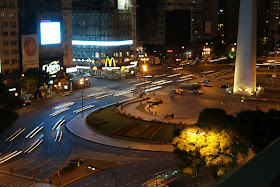 We started and ended the tour in Buenos Aires, AR's largest city and capital. The metropolitan population of BA is 13 million people and the city is the financial, industrial, commercial, and cultural hub of AR.
We started and ended the tour in Buenos Aires, AR's largest city and capital. The metropolitan population of BA is 13 million people and the city is the financial, industrial, commercial, and cultural hub of AR.I end the blog with some photos highlighting places we visited:
 Our hotel in BA, NH Tango, overlooked the Ave de Julio Nuevo and with a total of 18 lanes considered the widest street in the world
Our hotel in BA, NH Tango, overlooked the Ave de Julio Nuevo and with a total of 18 lanes considered the widest street in the world



 DID YOU KNOW?
DID YOU KNOW?"Although it has become to epitomize the glamour and elegance of high society, Tango has it's roots with the lonely immigrants and societal outcasts who lived in the improvished districts of BA.
The origins of tango dance developed as an "acting out" of the relationship between the prostitute and her pimp? The titles of the first tangos referred to characters in the world of prostitution.
The wail of the tango, it is said, speaks to more than frustrated love. It speaks of fatality of destinies engulfed in pain. It is the dance of sorrow.
During the first two decades of the 20th century, tango became very popular and became the staple of Argentinean high society.
The popularity of tango had its ups and downs through the mid-20th century and when Juan Peron rose to power in 1946, it reached the pinnacle of popularity as he and his wife Evita embraced it wholeheartedly.
Yet, with Evita's death in 1952, the tango again fell from the mainstream spotlight.
Today, the tango is enjoying a renaissance of popularity, keeping the fire of this daring art form burning brightly."

 Abuelas De Plaza Mayo
Abuelas De Plaza Mayo(Grandmothers)
In a plaza near the Boca District, I came across several powerful murals dedicated to the grandmothers of the children who disappeared in the period 1976 to 1983, a very dark period in Argentina history.
The kidnapping, murder and disappearance of over 500 children and babies were perpertrated by the military dictatorship which ruled the country during this time.
To this day, the search for many of these victims have not been yielded positive results.

 Also near the Boca District were a couple other murals dedicated to the fireman who saved many of the districts wooden buildings (above and below)
Also near the Boca District were a couple other murals dedicated to the fireman who saved many of the districts wooden buildings (above and below)
 On a balcony, there were three figures popular in Argentina history: soccer player, Evita, and a guy who looks like Prince Charles :-)
On a balcony, there were three figures popular in Argentina history: soccer player, Evita, and a guy who looks like Prince Charles :-) A neat art piece in the park - a large metal flower petal which opens up at day break and closes at night
A neat art piece in the park - a large metal flower petal which opens up at day break and closes at night The Recoleta Cemetery contains 4,691 vaults, all above ground, of which 94 have been declared National Historic Monuments. The cemetery contains graves of notable people, including Eva Peron and several presidents of Argentina.
The Recoleta Cemetery contains 4,691 vaults, all above ground, of which 94 have been declared National Historic Monuments. The cemetery contains graves of notable people, including Eva Peron and several presidents of Argentina.The cemetery is laid out into mini-city blocks with wide tree-lined main walkway branching into narrower sidewalks lined with mausoleums.
Many elaborate mausoleums in a variety of architectural styles - art-deco, art nouveau, Baroque, and neo-classic - are decorated with statues, columns and neo-classical gates.
While many of the mausoleums are in fine shape and well maintained, others have fallen into disrepair.


~~End of Andes to Patagonia Tour~~

















No comments:
Post a Comment